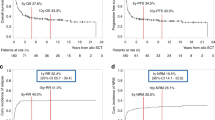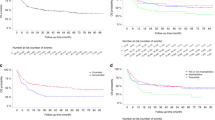Abstract
The prognosis of elderly patients with AML after chemotherapy is poor. Allo-SCT is feasible in these patients, but data on prognostic factors and outcome are limited. We analyzed all 102 AML patients ⩾55 years, who underwent allo-SCT at our institution from 1997 to 2008. OS and relapse-free survival (RFS) rates at 3 years are 39 and 37%, respectively. Multivariate analysis for OS revealed age ⩾60 years and active (refractory or untreated before allo-SCT) or advanced (>CR1) disease as adverse prognostic factors. Patients transplanted in CR1 had a 3-year OS of 67 vs 27% for patients with active/advanced disease. Multivariate analysis for RFS revealed active/advanced disease as the only adverse factor. Patients transplanted in CR1 had a 3-year RFS of 70 vs 22% for patients with active/advanced disease. In all, 17% of patients suffered from acute GVHD ⩾grade II. The risk for severe acute GVHD was increased after allo-SCT from mismatched donors. Nonrelapse mortality (NRM) was 23% at 1 year. The only risk factor for NRM was active/advanced disease. In conclusion, allo-SCT from related or unrelated donors yields very good results in elderly AML patients transplanted in CR1. Disease status at transplantation is the most important prognostic factor for transplantation success.
This is a preview of subscription content, access via your institution
Access options
Subscribe to this journal
Receive 12 print issues and online access
$259.00 per year
only $21.58 per issue
Buy this article
- Purchase on Springer Link
- Instant access to full article PDF
Prices may be subject to local taxes which are calculated during checkout



Similar content being viewed by others
References
Löwenberg B, Downing JR, Burnett A . Acute myeloid leukemia. N Engl J Med 1999; 341: 1051–1062.
Pulsoni A, Pagano L, Latagliata R, Casini M, Cerri R, Crugnola M et al. Survival of elderly patients with acute myeloid leukemia. Haematologica 2004; 89: 296–302.
Appelbaum FR, Gundacker H, Head DR, Slovak ML, Willman CL, Godwin JE et al. Age and acute myeloid leukemia. Blood 2006; 107: 3481–3485.
Frohling S, Schlenk RF, Kayser S, Morhardt M, Benner A, Dohner K et al. Cytogenetics and age are major determinants of outcome in intensively treated acute myeloid leukemia patients older than 60 years: results from AMLSG trial AML HD98-B. Blood 2006; 108: 3280–3288.
Schlenk RF, Benner A, Krauter J, Büchner T, Sauerland C, Ehninger G et al. Individual patient data-based meta-analysis of patients aged 16 to 60 years with core binding factor acute myeloid leukemia: a survey of the German Acute Myeloid Leukemia Intergroup. J Clin Oncol 2004; 22: 3741–3750.
Buchner T, Berdel WE, Haferlach C, Haferlach T, Schnittger S, Muller-Tidow C et al. Age-related risk profile and chemotherapy dose response in acute myeloid leukemia: a study by the German Acute Myeloid Leukemia Cooperative Group. J Clin Oncol 2009; 27: 61–69.
Wallen H, Gooley TA, Deeg HJ, Pagel JM, Press OW, Appelbaum FR et al. Ablative allogeneic hematopoietic cell transplantation in adults 60 years of age and older. J Clin Oncol 2005; 23: 3439–3446.
Ditschkowski M, Elmaagacli AH, Trenschel R, Steckel NK, Koldehoff M, Beelen DW . Myeloablative allogeneic hematopoietic stem cell transplantation in elderly patients. Clin Transplant 2006; 20: 127–131.
Aoudjhane M, Labopin M, Gorin NC, Shimoni A, Ruutu T, Kolb HJ et al. Comparative outcome of reduced intensity and myeloablative conditioning regimen in HLA identical sibling allogeneic haematopoietic stem cell transplantation for patients older than 50 years of age with acute myeloblastic leukaemia: a retrospective survey from the Acute Leukemia Working Party (ALWP) of the European group for Blood and Marrow Transplantation (EBMT). Leukemia 2005; 19: 2304–2312.
Ringden O, Labopin M, Ehninger G, Niederwieser D, Olsson R, Basara N et al. Reduced intensity conditioning compared with myeloablative conditioning using unrelated donor transplants in patients with acute myeloid leukemia. J Clin Oncol 2009; 27: 4570–4577.
Appelbaum FR . What is the impact of hematopoietic cell transplantation (HCT) for older adults with acute myeloid leukemia (AML)? Best Pract Res Clin Haematol 2008; 21: 667–675.
Ottinger HD, Muller CR, Goldmann SF, Albert E, Arnold R, Beelen DW et al. Second German consensus on immunogenetic donor search for allotransplantation of hematopoietic stem cells. Ann Hematol 2001; 80: 706–714.
Cheson BD, Bennett JM, Kopecky KJ, Buchner T, Willman CL, Estey EH et al. Revised recommendations of the international working group for diagnosis, standardization of response criteria, treatment outcomes, and reporting standards for therapeutic trials in acute myeloid leukemia. J Clin Oncol 2003; 21: 4642–4649.
Korn EL . Censoring distributions as a measure of follow-up in survival analysis. Stat Med 1986; 5: 255–260.
Fine JP, Gray RJ . A proportional hazards model for the subdistribution of a competing risk. J Am Stat Ass 1999; 94: 496–509.
Flynn CM, Hirsch B, Defor T, Barker JN, Miller JS, Wagner JE et al. Reduced intensity compared with high dose conditioning for allotransplantation in acute myeloid leukemia and myelodysplastic syndrome: a comparative clinical analysis. Am J Hematol 2007; 82: 867–872.
Martino R, Iacobelli S, Brand R, Jansen T, van BA, Finke J et al. Retrospective comparison of reduced-intensity conditioning and conventional high-dose conditioning for allogeneic hematopoietic stem cell transplantation using HLA-identical sibling donors in myelodysplastic syndromes. Blood 2006; 108: 836–846.
Shimoni A, Kroger N, Zabelina T, Ayuk F, Hardan I, Yeshurun M et al. Hematopoietic stem-cell transplantation from unrelated donors in elderly patients (age >55 years) with hematologic malignancies: older age is no longer a contraindication when using reduced intensity conditioning. Leukemia 2005; 19: 7–12.
Sorror ML, Maris MB, Storb R, Baron F, Sandmaier BM, Maloney DG et al. Hematopoietic cell transplantation (HCT)-specific comorbidity index: a new tool for risk assessment before allogeneic HCT. Blood 2005; 106: 2912–2919.
Sorror ML, Giralt S, Sandmaier BM, de LM, Shahjahan M, Maloney DG et al. Hematopoietic cell transplantation specific comorbidity index as an outcome predictor for patients with acute myeloid leukemia in first remission: combined FHCRC and MDACC experiences. Blood 2007; 110: 4606–4613.
Kiss TL, Sabry W, Lazarus HM, Lipton JH . Blood and marrow transplantation in elderly acute myeloid leukaemia patients—older certainly is not better. Bone Marrow Transplant 2007; 40: 405–416.
Sayer HG, Kroger M, Beyer J, Kiehl M, Klein SA, Schaefer-Eckart K et al. Reduced intensity conditioning for allogeneic hematopoietic stem cell transplantation in patients with acute myeloid leukemia: disease status by marrow blasts is the strongest prognostic factor. Bone Marrow Transplant 2003; 31: 1089–1095.
Schetelig J, Bornhauser M, Schmid C, Hertenstein B, Schwerdtfeger R, Martin H et al. Matched unrelated or matched sibling donors result in comparable survival after allogeneic stem-cell transplantation in elderly patients with acute myeloid leukemia: a report from the cooperative German Transplant Study Group. J Clin Oncol 2008; 26: 5183–5191.
Boehm A, Sperr WR, Leitner G, Worel N, Oehler L, Jaeger E et al. Comorbidity predicts survival in myelodysplastic syndromes or secondary acute myeloid leukaemia after allogeneic stem cell transplantation. Eur J Clin Invest 2008; 38: 945–952.
Sorror ML, Sandmaier BM, Storer BE, Maris MB, Baron F, Maloney DG et al. Comorbidity and disease status based risk stratification of outcomes among patients with acute myeloid leukemia or myelodysplasia receiving allogeneic hematopoietic cell transplantation. J Clin Oncol 2007; 25: 4246–4254.
Schmid C, Schleuning M, Schwerdtfeger R, Hertenstein B, Mischak-Weissinger E, Bunjes D et al. Long-term survival in refractory acute myeloid leukemia after sequential treatment with chemotherapy and reduced-intensity conditioning for allogeneic stem cell transplantation. Blood 2006; 108: 1092–1099.
Marks R, Potthoff K, Hahn J, Ihorst G, Bertz H, Spyridonidis A et al. Reduced-toxicity conditioning with fludarabine, BCNU, and melphalan in allogeneic hematopoietic cell transplantation: particular activity against advanced hematologic malignancies. Blood 2008; 112: 415–425.
Finke J, Bethge WA, Schmoor C, Ottinger HD, Stelljes M, Zander AR et al. Standard graft-versus-host disease prophylaxis with or without anti-T-cell globulin in haematopoietic cell transplantation from matched unrelated donors: a randomised, open-label, multicentre phase 3 trial. Lancet Oncol 2009; 10: 855–864.
Buchholz S, Krauter J, Dammann E, Beutel G, Stadler M, Eder M et al. Cytoreduction with clofarabine/Ara-C combined with reduced-intensity conditioning and allogeneic stem cell transplantation in patients with high-risk, relapsed, or refractory acute leukemia. Bone Marrow Transplant 2009; 43: S281–S282.
Hegenbart U, Niederwieser D, Sandmaier BM, Maris MB, Shizuru JA, Greinix H et al. Treatment for acute myelogenous leukemia by low-dose, total-body, irradiation-based conditioning and hematopoietic cell transplantation from related and unrelated donors. J Clin Oncol 2006; 24: 444–453.
Author information
Authors and Affiliations
Corresponding author
Ethics declarations
Competing interests
The authors declare no conflict of interest.
Rights and permissions
About this article
Cite this article
Krauter, J., Wagner, K., Stadler, M. et al. Prognostic factors in allo-SCT of elderly patients with AML. Bone Marrow Transplant 46, 545–551 (2011). https://doi.org/10.1038/bmt.2010.145
Received:
Revised:
Accepted:
Published:
Issue Date:
DOI: https://doi.org/10.1038/bmt.2010.145
Keywords
This article is cited by
-
Reduced-toxicity conditioning for allogeneic hematopoietic cell transplantation in elderly or comorbid patients with AML using fludarabine, BCNU and melphalan: disease stage at transplant determines outcome
Bone Marrow Transplantation (2018)
-
Outcome of allogeneic stem cell transplantation for AML and myelodysplastic syndrome in elderly patients (⩾60 years)
Bone Marrow Transplantation (2016)
-
Duration of first remission, hematopoietic cell transplantation-specific comorbidity index and patient age predict survival of patients with AML transplanted in second CR
Bone Marrow Transplantation (2013)
-
Prognostic factors in patients aged 50 years or older undergoing allogeneic hematopoietic stem cell transplantation for hematologic malignancy
International Journal of Hematology (2012)



